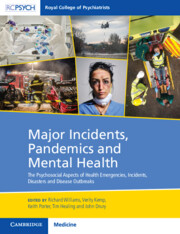 Major Incidents, Pandemics and Mental Health
Major Incidents, Pandemics and Mental Health Book contents
- Major Incidents, Pandemics and Mental Health
- Major Incidents, Pandemics and Mental Health
- Copyright page
- Dedication
- Contents
- Figures
- Tables
- Boxes
- Contributors
- Foreword by Dr Adrian James
- Foreword by Professor David Lockey
- Section 1 The Nature and Impacts of Twenty-First-Century Healthcare Emergencies
- Section 2 Clinical Aspects of Traumatic Injuries, Epidemics, and Pandemics
- Section 3 The Role of the Public in Emergencies: Survivors, Bystanders, and Volunteers
- Chapter 19 The Role of the Public: Understanding Group Processes in Emergencies, Incidents, Disasters, and Disease Outbreaks
- Chapter 20 Social Identity and Traumatic Stress in the Context of an Earthquake and a Pandemic
- Chapter 21 Mobilisation and Deterioration of Social Support Following Disasters Resulting from Natural and Human-Induced Hazards
- Chapter 22 Collective Responses to Terrorist Attacks
- Chapter 23 Collective Psychosocial Resilience as a Group Process Following Flooding
- Chapter 24 Facilitating the Public Response to COVID-19
- Chapter 25 The Social Psychology of Mass Casualty Decontamination in Chemical, Biological, Radiological, or Nuclear (CBRN) Incidents
- Chapter 26 Factors That Determine Wider Solidarity Responses After a Major Incident or Disaster
- Section 4 Responses to Meet the Mental Health Needs of People Affected by Emergencies, Major Incidents, and Pandemics
- Section 5 Sustaining and Caring for Staff During Emergencies
- Section 6 Designing, Leading, and Managing Responses to Emergencies and Pandemics
- Section 7 Key Lessons for the Way Forward
- A Glossary of Selected Key Terms Used in This Book
- Index
- References
Chapter 24 - Facilitating the Public Response to COVID-19
Group Processes and Mutual Aid
from Section 3 - The Role of the Public in Emergencies: Survivors, Bystanders, and Volunteers
Published online by Cambridge University Press: 11 January 2024
- Major Incidents, Pandemics and Mental Health
- Major Incidents, Pandemics and Mental Health
- Copyright page
- Dedication
- Contents
- Figures
- Tables
- Boxes
- Contributors
- Foreword by Dr Adrian James
- Foreword by Professor David Lockey
- Section 1 The Nature and Impacts of Twenty-First-Century Healthcare Emergencies
- Section 2 Clinical Aspects of Traumatic Injuries, Epidemics, and Pandemics
- Section 3 The Role of the Public in Emergencies: Survivors, Bystanders, and Volunteers
- Chapter 19 The Role of the Public: Understanding Group Processes in Emergencies, Incidents, Disasters, and Disease Outbreaks
- Chapter 20 Social Identity and Traumatic Stress in the Context of an Earthquake and a Pandemic
- Chapter 21 Mobilisation and Deterioration of Social Support Following Disasters Resulting from Natural and Human-Induced Hazards
- Chapter 22 Collective Responses to Terrorist Attacks
- Chapter 23 Collective Psychosocial Resilience as a Group Process Following Flooding
- Chapter 24 Facilitating the Public Response to COVID-19
- Chapter 25 The Social Psychology of Mass Casualty Decontamination in Chemical, Biological, Radiological, or Nuclear (CBRN) Incidents
- Chapter 26 Factors That Determine Wider Solidarity Responses After a Major Incident or Disaster
- Section 4 Responses to Meet the Mental Health Needs of People Affected by Emergencies, Major Incidents, and Pandemics
- Section 5 Sustaining and Caring for Staff During Emergencies
- Section 6 Designing, Leading, and Managing Responses to Emergencies and Pandemics
- Section 7 Key Lessons for the Way Forward
- A Glossary of Selected Key Terms Used in This Book
- Index
- References
Summary
This chapter seeks to understand the psychological facilitators of active community engagement with the public health response to successful responses to disease outbreaks. It summarises research on the key psychological predictors of engagement in protective behaviours in the COVID-19 pandemic, it describes how mutual aid groups have helped people to shield and self-isolate during the pandemic, and it summarises research on the factors that have sustained these groups over time. It draws out the general principles and the policy and practice implications that emerge from the research on this topic. The focus is largely on evidence from the UK, although many of the points covered in this chapter apply equally to the situation in other countries.
- Type
- Chapter
- Information
- Major Incidents, Pandemics and Mental HealthThe Psychosocial Aspects of Health Emergencies, Incidents, Disasters and Disease Outbreaks, pp. 166 - 172Publisher: Cambridge University PressPrint publication year: 2024
